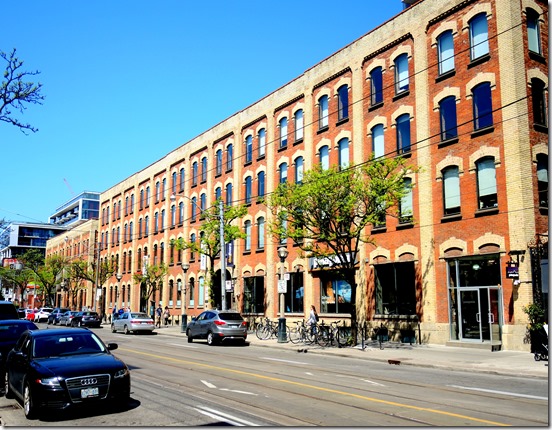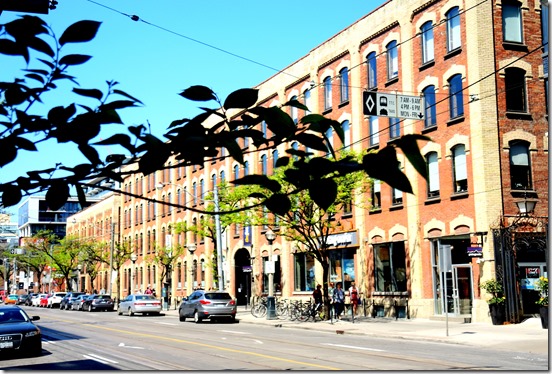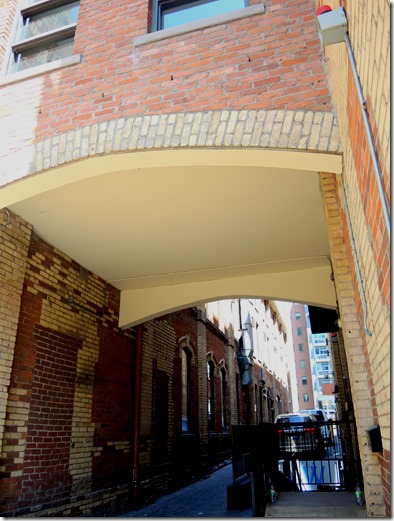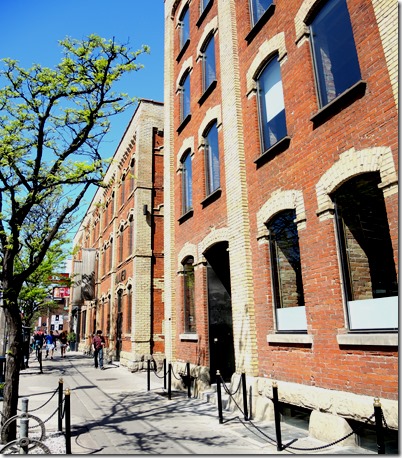The Gurney Iron Foundry on King Street West on April 13, 1927. Toronto Archives, S0071, It.4812 (1)
The magnificent Victorian buildings, constructed of red and yellow brick, are among the oldest industrial structures in the city. The building on the east (closest to Spadina) is the oldest. With a history that spans almost a century and a half, the E. C. Gurney Company, originated in Hamilton, Ontario. Edward and Charles Gurney manufactured stoves and general castings. When business expanded, the Gurney brothers opened a retail store in Toronto at 91 Yonge Street. Edward Gurney Junior relocated to Toronto to manage the family business in the provincial capital, purchasing a residence at 209 Jarvis Street for his family.
During the 1870s, much of the land along King Street West was vacant, although it was privately owned. Children in the area ran freely in the fields, kicking a ball and shouting to friends to join in their game. In autumn, the grasshoppers flew in clouds as the children raced along the paths among the fields. In winter, they built snow forts, engaged in snowball fights, and employed creative cursing when they received a direct hit in the face. However, it was soon to change, as the natural playground was to be buried beneath an enormous industrial complex.
Intending to build a factory in Toronto, in 1872, the Gurney Company bought several of the lots on King, west of Spadina, and erected a four-storey building. Located on the east side of the property, its brick walls were particularly attractive, especially the yellow-brick designs above the windows and the yellow-brick pilasters (fake columns) that commenced at the ground level and rose to the top of the building. In 1872, the postal address of the factory was 356 King Street, but today it is 500–510 King Street West. They also constructed more buildings to the north of the King Street structures, but they have not survived into the modern era.
When the building that today has the postal address 500-510 King Street opened, a newspaper advertisement stated, “Gurney Stove Foundry, manufacturing agent for the famed Buttan Heater.”
The business expanded and in 1887 they constructed a three-storey building to the west of the original site. Its address today is 522 King Street. A narrow laneway separated the two structures. During the following years, other buildings appeared to the north of the original two, but these have since been demolished.
The buildings deteriorated throughout the years ahead and their attractive facades were covered with a tin siding. In the modern era, when its owners decided to restore the buildings, they removed the tin, revealing the attractive brickwork. It now appears as it did in yesteryear. During the restoration, they replaced the cornices on both structures with metal trim.
In the laneway between the two surviving buildings on King Street, they erected a connecting passageway at the second and third-floor levels. Thankfully, it matches the two existing buildings. Today, multiple tenants are located within. With its polished original oak floors and massive wood beams of old-growth Canadian pine, it possesses some of the most handsome nineteenth-century rental spaces in the city.
Viewing these restored buildings today, it is difficult to imagine them being a part of a bustling, sooty, industrial complex, with hundreds of workers labouring in hot, fetid conditions to tend the furnaces, shovelling coal to keep the fires alive. It was an era when workers possessed few rights. Wages were poor and hours were long, usually nine or ten hours a day, six days a week. Lung disease and work-related illnesses were common.
To the modern eye, these factories appear pristine and quaint, their patterned brickwork attractive to behold. The massive pine pillars within them inspire awe, as no trees remain in Ontario to obtain such magnificent giants ever again.
No trace remains of the hardworking labourers who once worked on these premises. Evidence of their joys and sorrows has long departed the scene. Only the rattle of the streetcars on the street or the shout of a truck driver remind us of earlier days, when this was a busy industrial complex. The past has departed forever, but evidence of earlier days remains through the presence of these attractive historic buildings.
The buildings that were formerly the Gurney Iron Foundry. Photo May 2015.
Old Gurney Iron Foundry Building in 2015.
Passageway that was built to joint the two buildings together.
South facade of the two buildings that were jointed by the passageway.
To view the Home Page for this blog: https://tayloronhistory.com/
To view previous blogs about movie houses of Toronto—historic and modern
Recent publication entitled “Toronto’s Theatres and the Golden Age of the Silver Screen,” by the author of this blog. The publication explores 50 of Toronto’s old theatres and contains over 80 archival photographs of the facades, marquees and interiors of the theatres. It relates anecdotes and stories of the author and others who experienced these grand old movie houses.
To place an order for this book:
Book also available in Chapter/Indigo, the Bell Lightbox Book Store and by phoning University of Toronto Press, Distribution: 416-667-7791
Theatres Included in the Book:
Chapter One – The Early Years—Nickelodeons and the First Theatres in Toronto
Theatorium (Red Mill) Theatre—Toronto’s First Movie Experience and First Permanent Movie Theatre, Auditorium (Avenue, PIckford), Colonial Theatre (the Bay), the Photodrome, Revue Theatre, Picture Palace (Royal George), Big Nickel (National, Rio), Madison Theatre (Midtown, Capri, Eden, Bloor Cinema, Bloor Street Hot Docs), Theatre Without a Name (Pastime, Prince Edward, Fox)
Chapter Two – The Great Movie Palaces – The End of the Nickelodeons
Loew’s Yonge Street (Elgin/Winter Garden), Shea’s Hippodrome, The Allen (Tivoli), Pantages (Imperial, Imperial Six, Ed Mirvish), Loew’s Uptown
Chapter Three – Smaller Theatres in the pre-1920s and 1920s
Oakwood, Broadway, Carlton on Parliament Street, Victory on Yonge Street (Embassy, Astor, Showcase, Federal, New Yorker, Panasonic), Allan’s Danforth (Century, Titania, Music Hall), Parkdale, Alhambra (Baronet, Eve), St. Clair, Standard (Strand, Victory, Golden Harvest), Palace, Bedford (Park), Hudson (Mount Pleasant), Belsize (Crest, Regent), Runnymede
Chapter Four – Theatres During the 1930s, the Great Depression
Grant ,Hollywood, Oriole (Cinema, International Cinema), Eglinton, Casino, Radio City, Paramount, Scarboro, Paradise (Eve’s Paradise), State (Bloordale), Colony, Bellevue (Lux, Elektra, Lido), Kingsway, Pylon (Royal, Golden Princess), Metro
Chapter Five – Theatres in the 1940s – The Second World War and the Post-War Years
University, Odeon Fairlawn, Vaughan, Odeon Danforth, Glendale, Odeon Hyland, Nortown, Willow, Downtown, Odeon Carlton, Donlands, Biltmore, Odeon Humber, Town Cinema
Chapter Six – The 1950s Theatres
Savoy (Coronet), Westwood
Chapter Seven – Cineplex and Multi-screen Complexes
Cineplex Eaton Centre, Cineplex Odeon Varsity, Scotiabank Cineplex, Dundas Square Cineplex, The Bell Lightbox (TIFF)





![cid_E474E4F9-11FC-42C9-AAAD-1B66D852[1] cid_E474E4F9-11FC-42C9-AAAD-1B66D852[1]](https://tayloronhistory.com/wp-content/uploads/2015/05/cid_e474e4f9-11fc-42c9-aaad-1b66d8521_thumb6.jpg)


I found this article very interesting. My father has been in the appliance business all of his life and I grew up not far from there. When I was younger I lived on Sheppard Avenue and Young Street. Recently I bought a property and in the storage unit was a chancellor stole built by the Gurney foundry. If anyone would be interested in purchasing this historic piece I would appreciate being contacted at [email protected].
that was an early 1900’s Gurney Foundry stove. the patent plate says 1907. It is now residing in Alberta and since my last post l have read there were distribution centers in Manitoba and BC.
My grandmother, Margaret Adams purchased the Gurney residence at 44 Walmer Road in the latter 1940’s.
I would appreciate any information or pictures of this home, either in her ownership or the original Gurney family. This house is no longer there as it was sold in 1963 to be replaced by an apartment building. Sometimes progress can be so destructive.
I have a E. & C. Gurney wood stove.
It was purchased in Toronto Ont in approx 1965
I now reside in Texas and have been transporting this stove from place to place for many many years. It is a princess No. 25. Very ornate But I cannot find a date on it.
Wondering if any one can provide any information on this stove.
It is stamped E. & C. Gurney Toronto Ont
830 444-9912 [email protected]
Thank you